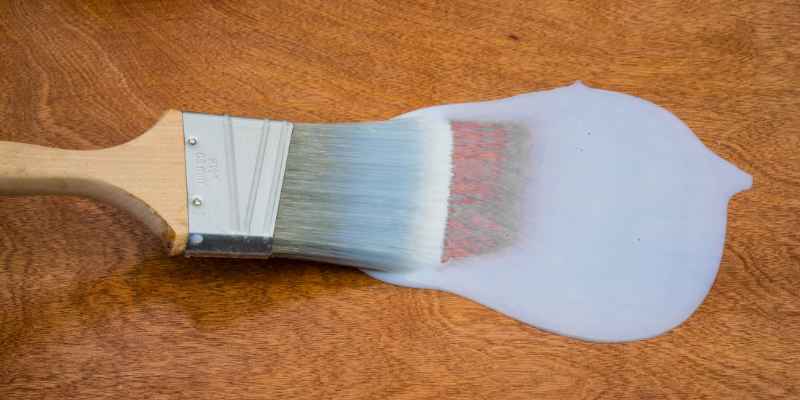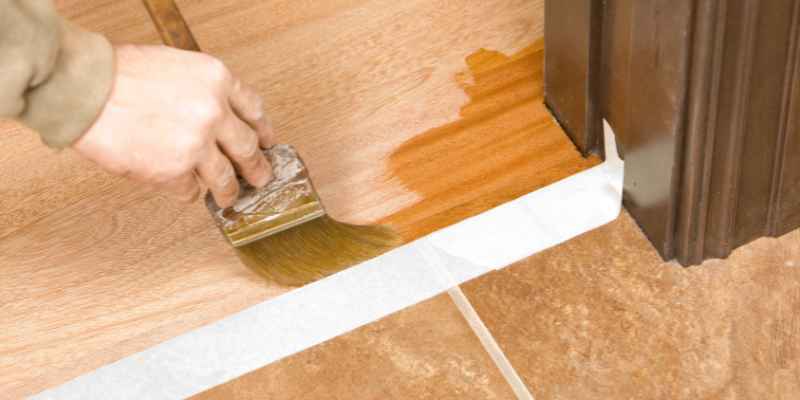Yes, water-based polyurethane can be applied over oil-based polyurethane. Now, let’s explore the compatibility of these two types of polyurethane finishes in more detail.
Water-based polyurethane and oil-based polyurethane are both popular choices for finishing wooden surfaces. While traditionally it was believed that water-based polyurethane couldn’t be applied over oil-based polyurethane, modern advancements in technology have made it possible. However, proper preparation and careful application are key to ensuring a successful outcome.
We will discuss the compatibility of water-based and oil-based polyurethane finishes, the necessary steps for application, and some general guidelines to keep in mind. Whether you’re exploring options for refinishing an existing surface or looking to switch between these types of finishes, our comprehensive guide will help you make an informed decision. So let’s dive in!
Understanding Polyurethane Finishes
Water based polyurethane can be applied over oil based polyurethane, but there are key considerations. Proper surface preparation, sanding, and using the right products are vital for a successful application. Always test a small area before proceeding with the entire project.
When it comes to wood finishes, polyurethane is a popular choice due to its durability and protective qualities. However, there are different types of polyurethane finishes available, with water-based and oil-based varieties being the most common. In this article, we will delve into the differences between these two types and explore their advantages and disadvantages. So, if you’re considering a polyurethane finish for your wood project and wondering whether you can put water-based polyurethane over oil-based polyurethane (or vice versa), keep reading to gain a deeper understanding of these finishes.
Difference Between Water Based And Oil Based Polyurethane
When it comes to polyurethane finishes, the main difference lies in their base composition. Water-based polyurethane is made using water as the carrier, while oil-based polyurethane uses mineral spirits or other petroleum-based solvents. This distinction leads to variations in application, appearance, and performance.
Advantages And Disadvantages Of Water Based Polyurethane
Water-based polyurethane offers several advantages that make it a popular choice for many woodworking projects:
1. Easy Cleanup: It can be cleaned up with soap and water, making it convenient and user-friendly.
2. Quick Drying Time: Water-based polyurethane dries relatively faster compared to its oil-based counterpart, allowing for quicker project completion.
3. Low Odor: Unlike oil-based polyurethane, water-based polyurethane has a low odor, making it more pleasant to work with.
4. Clear Finish: It dries to a crystal-clear finish, preserving the natural beauty of the wood.
Despite its advantages, water-based polyurethane does have some drawbacks:
1. Less Depth and Warmth: It may not provide the same depth and warmth as oil-based polyurethane, resulting in a slightly less rich appearance.
2. Multiple Coats: Water-based polyurethane usually requires multiple coats to achieve the desired level of protection and durability.
Advantages And Disadvantages Of Oil Based Polyurethane
Oil-based polyurethane remains a popular choice for many woodworkers due to its unique qualities:
1. Rich Appearance: Oil-based polyurethane enhances the natural wood color and grain, providing a warm and rich finish.
2. Fewer Coats: It typically requires fewer coats compared to water-based polyurethane to achieve a durable and protective finish.
3. Superior Durability: Oil-based polyurethane is generally considered to be more durable and resistant to wear and tear, offering long-lasting protection.
However, oil-based polyurethane also has its disadvantages:
1. Longer Drying Time: It takes a longer time to dry fully, which can delay project completion.
2. Strong Odor: The solvents used in oil-based polyurethane give off a strong odor during application and drying, necessitating proper ventilation.
3. Cleanup Challenges: Cleaning brushes and tools used with oil-based polyurethane requires the use of harsh chemicals such as mineral spirits.
In conclusion, both water-based and oil-based polyurethane finishes have their advantages and disadvantages. While it is possible to apply water-based polyurethane over oil-based polyurethane with proper preparation, it is generally recommended to stick with the same type of polyurethane for the best results. Consider your specific project requirements, preferences, and the condition of the existing finish before making a decision.

Compatibility Of Water Based And Oil Based Polyurethane
When it comes to finishing wood surfaces, polyurethane is a popular choice for its durability and protective qualities. However, there are different types of polyurethane, namely water based and oil based, which are not always compatible with each other. Understanding the compatibility of water based and oil based polyurethane is crucial before making any decisions about applying one over the other.
Can You Put Water Based Polyurethane Over Oil Based Polyurethane?
Many people wonder if it is possible to apply water based polyurethane over a surface that has been previously coated with oil based polyurethane. The answer is: yes, but with some important considerations.
Why Compatibility Matters
Before delving into the factors to consider before applying water based polyurethane over oil based polyurethane, it’s important to understand why compatibility between the two is crucial. Water based and oil based polyurethane have different chemical compositions, which can lead to adhesion issues if not handled correctly. Applying water based polyurethane over oil based polyurethane without proper preparation can result in a finish that doesn’t adhere well, leading to premature peeling, chipping, or bubbling.
Factors To Consider Before Applying Water Based Polyurethane Over Oil Based Polyurethane
Before proceeding with the application of water based polyurethane over oil based polyurethane, it is essential to consider the following factors:
- Surface Preparation: To ensure proper adhesion, the surface must be thoroughly cleaned and sanded to remove any dirt, dust, or wax. This will create a rough surface for the new polyurethane to adhere to.
- Compatibility Test: Perform a compatibility test on a small, inconspicuous area to determine if the water based polyurethane will adhere well to the existing oil based polyurethane. Apply a small amount of water based polyurethane and observe for any signs of poor adhesion.
- Sanding Between Coats: If the compatibility test shows satisfactory results, sanding between coats is essential. Lightly sanding the previous coat of oil based polyurethane will create a better surface for the water based polyurethane to bond with.
- Additional Coats: Applying multiple coats of water based polyurethane over oil based polyurethane may improve the adhesion and durability of the finish. However, it is crucial to follow the manufacturer’s instructions for drying time between coats.
- Proper Ventilation: It is important to work in a well-ventilated area when applying water based polyurethane over oil based polyurethane. Proper ventilation ensures that any fumes or vapors are safely dispersed, minimizing health risks.
By considering these important factors and taking proper precautions, it is possible to successfully apply water based polyurethane over oil based polyurethane. However, it’s always advisable to consult the manufacturer’s instructions and seek professional advice if you are uncertain about the compatibility of the two finishes.
Steps To Apply Water Based Polyurethane Over Oil Based Polyurethane
Yes, you can apply water-based polyurethane over oil-based polyurethane by following these steps carefully. Make sure to clean the surface, lightly sand it, and apply a thin coat of water-based polyurethane evenly. Let it dry completely before adding additional coats for a smooth finish.
Applying water-based polyurethane over oil-based polyurethane may seem like a daunting task, but with the right preparation and proper technique, it can be successfully accomplished. In this section, we will walk you through the steps you need to follow to achieve a smooth and flawless finish. From prepping the surface to applying the water-based polyurethane, we’ve got you covered.
Preparation Of The Surface
Before you begin applying the water-based polyurethane, it is crucial to prepare the surface properly. Follow these steps to ensure a clean and ready-to-use surface:
- Start by thoroughly cleaning the existing polyurethane surface. Use a mild cleaner or a mixture of dish soap and water to remove any dirt, grime, or wax buildup. Rinse the surface with clean water and allow it to dry completely.
- Next, inspect the surface for any imperfections such as cracks, chips, or scratches. Fill these areas with a wood filler or putty, smoothing it out with a putty knife. Sand the filled areas until they are level with the surrounding surface.
- Pro Tip: To ensure a smooth and even finish, lightly sand the entire surface using fine-grit sandpaper. This will help the water-based polyurethane adhere better to the oil-based polyurethane and remove any gloss that might prevent proper adhesion.
Sanding The Existing Polyurethane
Sanding the existing polyurethane is a crucial step in the process. This helps create a rough surface for the water-based polyurethane to adhere to. Follow these steps to sand the existing polyurethane:
- Begin by using a medium-grit sandpaper, such as 120 grit, to lightly sand the entire surface. Sand in the direction of the wood grain.
- After sanding, wipe away any dust or debris from the surface using a damp cloth or tack cloth.
- Pro Tip: For a smoother finish, follow up with a finer-grit sandpaper, such as 220 grit, to gently sand the surface once again. This will help create an even smoother surface for the water-based polyurethane application.
Applying Water Based Polyurethane
Now that the surface is prepped and sanded, it’s time to apply the water-based polyurethane. Follow these steps for a seamless application:
- Pour the water-based polyurethane into a clean container, such as a paint tray.
- Using a synthetic bristle brush or a foam applicator, apply a thin and even coat of water-based polyurethane to the surface. Work in long, overlapping strokes, following the direction of the wood grain.
- Allow the first coat to dry completely, following the manufacturer’s instructions for drying time.
- Repeat the application process, applying additional thin coats as needed to achieve the desired level of protection and sheen. Ensure each coat dries completely before applying the next coat.
Tips For A Successful Application
To ensure a successful application of water-based polyurethane over oil-based polyurethane, keep these tips in mind:
- Tip 1: Always read and follow the manufacturer’s instructions for both the water-based polyurethane and the oil-based polyurethane.
- Tip 2: Apply thin coats of water-based polyurethane to avoid drips, bubbles, or uneven drying.
- Tip 3: Sand lightly between coats of water-based polyurethane to create a smooth finish.
- Tip 4: Use a high-quality brush or foam applicator for better control and even application.
- Tip 5: Avoid shaking the container of water-based polyurethane, as it can introduce air bubbles. Instead, gently stir the polyurethane to mix it thoroughly.
By following these steps and tips, you can successfully apply water-based polyurethane over oil-based polyurethane, achieving a beautiful and durable finish for your wood surfaces. Remember to take your time, work in a well-ventilated area, and be patient during the drying process.

Alternatives To Applying Water Based Polyurethane Over Oil Based Polyurethane
When it comes to refinishing wood surfaces, one common question that arises is whether you can put water-based polyurethane over oil-based polyurethane. While the process might seem straightforward, it’s important to consider alternatives if you want to avoid potential issues with the finish. In this section, we’ll explore three alternatives to applying water-based polyurethane over oil-based polyurethane: removing the existing polyurethane, using a compatible topcoat, and consulting a professional.
Removing The Existing Polyurethane
If you’re looking to switch from oil-based polyurethane to water-based polyurethane, one option is to remove the existing polyurethane altogether. This involves stripping the old finish from the wood surface before applying the new one. While it can be a labor-intensive process, it ensures a clean slate for the water-based polyurethane to adhere to. Here are a few methods you can consider for removing the existing polyurethane:
- Sanding: Sanding the wood surface with coarse sandpaper helps remove the top layer of polyurethane. Gradually work your way down to finer grit sandpaper until the surface is smooth and ready for the new finish.
- Chemical stripping: Using a paint stripper or chemical remover can help dissolve the existing polyurethane. Follow the manufacturer’s instructions and use caution when handling chemicals, ensuring proper ventilation and wearing protective gear.
Using A Compatible Topcoat
If removing the existing polyurethane is not feasible or desirable, you can consider using a compatible topcoat instead. There are specific topcoats available in the market that can be applied over oil-based polyurethane, creating a strong bond between the two finishes. These topcoats are specially formulated to provide a protective layer and enhance the durability of the existing polyurethane. It’s important to choose a topcoat that is compatible with both the existing polyurethane and the desired water-based polyurethane for optimal results. Consult the manufacturer’s recommendations and follow the application instructions carefully.
Consulting A Professional
If you’re unsure about the best approach or don’t have the time and resources to undertake the refinishing process yourself, it’s wise to consult a professional. A professional refinishing expert will have the necessary knowledge and experience to assess the condition of your wood surfaces, recommend the most suitable alternatives, and ensure a flawless finish. They can guide you in choosing the right products, provide expert advice on application techniques, and handle the refinishing process efficiently. Hiring a professional saves you time and guarantees a high-quality result.
By considering these alternatives to applying water-based polyurethane over oil-based polyurethane, you can make an informed decision about the best approach for refinishing your wood surfaces. Whether you choose to remove the existing polyurethane, use a compatible topcoat, or consult a professional, remember to prioritize the longevity and durability of the finish to protect and enhance the beauty of your wood surfaces.
Conclusion
Applying water-based polyurethane over oil-based polyurethane is possible with proper preparation. However, it is crucial to sand the surface thoroughly to ensure adhesion. Additionally, test a small area beforehand to ensure compatibility and desired results. Remember to follow the manufacturer’s instructions for best practices.
Ultimately, this allows for a more versatile approach in achieving the desired finish for your project.


